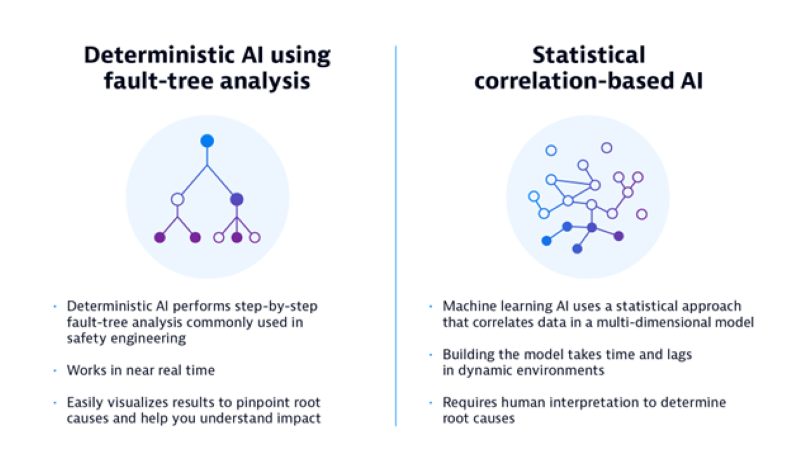Today's organizations need to go beyond a traditional, correlation-driven approach to identify the underlying causes and effects of an event or behavior and drive better DevOps automation. Enter causal AI.
Today’s organizations need to solve increasingly complex human problems, making advancements in artificial intelligence (AI) more important than ever. Conventional data science approaches and analytics platforms can predict the correlation between an event and possible sources. But they often fall short when it comes to understanding why an event occurred. That’s where causal AI, also referred to as deterministic AI, makes a crucial difference.
In what follows, we’ll discuss causal AI, how it works, and how it compares to other types of artificial intelligence. We’ll also discuss why it’s essential for business success in the age of generative AI.
What is causal AI?
Causal AI is an artificial intelligence technique used to determine the exact underlying causes and effects of events or behaviors. Unlike correlation-based machine learning, which calculates probabilities based on statistics, causal AI uses fault-tree analysis to determine system-level failures based on component-level failures. With this systematic, top-down approach, causal AI and modern deterministic AIOps provide a determinative basis for automatic anomaly detection, root-cause analysis, security risk ranking, and business impact assessment.
Causal AI draws on supporting data, such as relationships, dependencies, and other context among network entities and events. With this context, causal AI determines the precise root cause of an issue. This approach helps teams to develop effective models or interventions for change while also predicting their potential effectiveness. It can increase confidence in business and IT decision making by clearly connecting events to an intended or unintended outcome.
The deterministic quality of causal AI can also form the foundation for reliable recommendations from emerging generative AI technologies.
Why is causal AI important?
Most AIOps approaches use predictive analytics that apply algorithms and machine learning to historical data to predict future outcomes. Such an outcome could be a CPU spike that progresses into a system failure. Predictive analysis helps an organization manage resources and improve incident response times.
This blind spot between the underlying cause and resulting effect can lead to unwanted bias and poor decision making. Predictive analysis can observe an event and predict an outcome will occur, but it can’t show that the outcome occurred because of the event. In other words, correlation doesn’t equal causation.
Causal AI, on the other hand, identifies the underlying cause of an event and its precise relationship to the outcome. Organizations can use causal AI frameworks and algorithms to ask questions and gain a deeper understanding of their CloudOps, DevOps, and SecOps use cases. For instance, these questions can include the following:
- Why aren’t customers completing their transactions?
- What’s causing customer churn?
- Why is this application sluggish at certain times of the day?
Additionally, the deterministic AI approach of causal AI can determine the cause-and-effect relationship of events from a combination of metrics, traces, and log data, as well as user behavior data and other details. Thus, teams can resolve incidents immediately to prevent disruptions in service and keep an organization in compliance with service-level agreements.
Correlation AI vs. causal AI: Weighing the differences

Correlation-based machine learning models predict outcomes from statistical relationships and are useful in many scenarios. For example, facial recognition, personal shopping, and predictive maintenance.
However, the shortcomings of correlation-based AI become evident when teams need to determine how an action would affect an outcome. While predictive models can identify the likelihood of certain positive or negative events happening, they’re unable to explain how they arrived at that forecast. They’re also unable to identify the underlying factors and cause-and-effect relationships.
Correlation-based AI and causal AI have a few additional differences, including the following:
| Correlation-based AI | Causal AI |
| Correlation-based AI relies on statistics to provide assumptions about what’s happening. | Causal AI can clearly trace and explain exactly what’s happening at every step based on specific contextual data. |
| Correlation-based AI is probabilistic and requires humans to verify the accuracy of results. | Causal AI is fact-based and thus can do automated analyses. |
| Correlation-based AI can make only predictions with limited ability to explain an event. | Causal AI, on the other hand, provides details on how it arrived at a conclusion. |
| Correlation-based AI needs to be checked for bias due to the limitations of various data, algorithms, or sampling. | Causal AI, however, relies on actual data and not training data and is therefore not prone to bias issues. |
| Correlation-based AI may be completely off base in novel situations. | Causal AI can adapt to new situations and find unknown unknowns. |
How does causal AI work?
Causal AI essentially works in two steps. First, it collects information and discovers problems within the data set. Then, it looks for causal relationships that help explain those issues using a plan devised from the collected data.
To better understand how causal AI works, it’s important to understand fault-tree analysis—a data-driven, fault-tree methodology used for causality analysis. Fault-tree analysis uses boolean logic to explore system-level failures. It’s a top-down approach used to identify the component-level failure, or basic event, that caused the system-level failure, or top event.
Causal AI that uses fault-tree analysis works the following way:
- Defines the scope of the system and what’s considered a failure.
- Defines top-level faults and the analysis starting point with details of the failure.
- Identifies precipitating events that could cause the top-level fault to occur, whether alone or with multiple concurring events.
- Finds the root causes of each precipitating event and event sequence.
- Analyzes the fault tree by looking for the events that lead to failure or are most likely to fail.
With the certainty of this systematic approach, teams can gain insight into ways to mitigate paths to failure and support system improvements, and automate resolutions.
Applying causal AI to your organization
Dynatrace Davis® AI offers continuous causal analysis to the code level that maps and understands the relationships between all of an organization’s networks, applications, and services. Using fault-tree analysis, this causal AI approach seamlessly combines topological context with metric data to quickly identify observability signals for any behavior of interest. The analysis provides insights into every entity a problem affects, enabling developers to solve problems without having to reproduce errors.
With its deterministic AI approach, causal AI provides the perfect basis for automating responses and supplying facts for reliable generative AI recommendations.




Looking for answers?
Start a new discussion or ask for help in our Q&A forum.
Go to forum